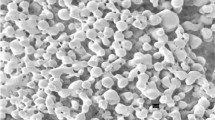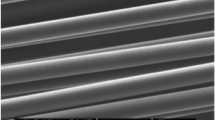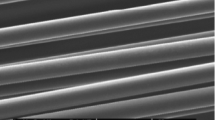Abstract
The choice of materials depends on the performance requirements of the system and many other factors including size, weight, mechanical load, environment, number of systems required, and cost. In this context, we have studied and investigated, using the genetic approach and the nonlinear acoustic technique, the effect of mechanical and thermal stresses on fiber–matrix interface damage of E-Glass/Poly (methyl methacrylate)-PMMA and Coconut/PMMA composite and biocomposite material, respectively. The results of the genetic modeling are in good agreement with the nonlinear acoustic technique results. We have found a difference in fiber–matrix interface damage between the two materials Coconut/PMMA and E-Glass/PMMA is in the order of 0.02–0.09. The results of statistical analysis based on the values of the correlation coefficients, which are very nearly to 1 (0.9991 and 0.9938), have proved the convergence of genetic results. This finding confirms the conclusions found by several researchers where they have showed that coconut fibers are potential candidates for the reinforcement of civil engineering structures, in building materials and wireless communication devices due to their better physical and mechanical properties, and that coconut fiber can be a potential candidate to partially replace glass fiber in certain areas mentioned above and confirmed by very recent and interesting studies dated in 2020 and 2021.












Similar content being viewed by others
References
Newswander T, Paquin RA (2017) Materials for optical systems from: handbook of optomechanical engineering. CRC Press, London. https://doi.org/10.4324/9781315153247-3
Gagné V (2011) Utilisation des profiles en matériaux composites dans les lignes aériennes de transport dénergie électrique. Université de Sherbrooke, Sherbrooke
Li F, Lania K, Wang X, Xue G, Winter HH (2010) Steric effects on the rheology of nanocomposite gels of organoclay in dicarboxyl-terminated polybutadiene. Soft Matter 6:2442–2448
Daniela SR, Paul B (2018) Correlation of rheological properties of ferrofluid-based magnetorheological fluids using the concentration-magnetization superposition. J Rheol 62:739
Hsissou R, Benzidia B, Hajjaji N, Elharfi A (2018) Elaboration and electrochemical studies of the coating behavior of a new nanofunctional epoxy polymer on E24 steel in 3.5% NaCl. Port Electrochem Acta 36:259–270
Winter HH (2009) Three views of viscoelasticity for Cox-Merz materials. Rheol Acta 48:241–243
Hsissou R, Berradi M, El Bouchti M et al (2019) Synthesis characterization rheological and morphological study of a new epoxy resin pentaglycidyl ether pentaphenoxy of phosphorus and their composite (PGEPPP/MDA/PN). Polym Bull 76:4859–4878. https://doi.org/10.1007/s00289-018-2639-9
Ayad AH, Faisal A, Dooraid NA, Mashallah R, Sivarajasekar N, Sharma G (2021) Cost-effective composite prepared from sewage sludge waste and cement kiln dust as permeable reactive barrier to remediate simulated groundwater polluted with tetracycline. J Environ Chem Eng 9:105194
Hsissou R, El Rhayam Y, El Harfi A (2014) Synthesis and characterization of a new epoxy resin homologous to DGEBA (diglycidyl 3-Aminopropyl Triethyl Silane): a study of thermal properties. Int J Innov Appl Stud 7:674–682
Gohardani O, Williamson DM, Hammond DW (2012) Multiple liquid impacts on polymeric matrix composites reinforced with carbon nanotubes. J Wear 294–295:336–346
Panchavarnam D, Menaka S, Anitha A, Arulmozhi MA (2016) Comparative study on the properties of ZnO And ZnS Nanoparticles. Inter J ChemTech Res 9:308–315
Sungsanit K, Kao N, Bhattacharya SN, Pivsaart S (2010) Physical and rheological properties of plasticized linear and branched PLA. Korea Aust Rheol J 22:187–195
Zhang Y, Park SJ (2017) Enhanced interfacial interaction by grafting carboxylated-macromolecular chains on nanodiamond surfaces for epoxy-based thermosets. J Polym Sci Part B 55:1890–1898
Zhang Y, Choi JR, Park SJ (2017) Thermal conductivity and thermo-physical properties of nanodiamond-attached exfoliated hexagonal boron nitride/epoxy nanocomposites for microelectronics. Compos Part A 101:227–236
Alvaro R, María T, Acevedo RR (2016) mechanical properties of laminate of residual polyester resin reinforced with recycled newspaper. Inter J ChemTech Res 9:257–262
Vadivelan S, VictorJaya N (2015) Investigation of structural, thermal and magnetic properties of strontium substituted barium hexaferrite synthesized via coprecipitation method. Inter J ChemTech Res 8:404–410
Sharaf S, Farouk A, Abd El-Hady MM (2016) Novel conductive textile fabric based on polyaniline and CuO Nanoparticles. Inter J PharmTech Res 9:461–472
Shahenoor Basha SK, Sunita Sundari G, Vijay Kumar K (2016) Optical, thermal and electrical studies of PVP based solid polymer electrolyte for solid state battery applications. Inter J ChemTech Res 9:165–175
Kota AK, Cipriano BH, Duesterberg MK, Gerhson AL, Powell D, Ragharan SR, Bruck HA (2007) Electrical and rheological percolation in polystyrene/MWCNT nanocomposites. Macromolecules 40:7400–7406
Vijayalakshmi A, Vidyavathy B, Chithra B, Hemamalini M (2015) Synthesis, growth, optical, thermal and dielectric studies of lead boro glutamate (PbBG). Inter J ChemTech Res 8:638–642
Hsissou R, El Harfi A (2016) Theoretical, experimental and viscometric studies of a new phosphorus trifonctionnel epoxy polymer: Triglycidyl Dihydroxy Diphenyl Ether Phosphoric Ester (TGDHDPEPE). Moroc J Chem 4:315–323
Hsissou R, Bekhta A, El Harfi A (2017) Viscosimetric and rheological studies of a new trifunctional epoxy pre-polymer with noyan ethylene: triglycidyl ether of ethylene of bisphenol A (TGEEBA). J Mater Environ Sci 8:603–610
Hsissou R, El-Harfi A (2020) Rheological behavior of three polymers and their hybrid composites (TGEEBA/MDA/PN), (HGEMDA/MDA/PN) and (NGHPBAE/MDA/PN). J King Saud Univ Sci 32:235–244
Aghadavoudi F, Golestanian H, Zarasvand KA (2018) Elastic behaviour of hybrid cross-linked epoxy-based nanocomposite reinforced with GNP and CNT: experimental and multiscale modelling. Polym Bull. https://doi.org/10.1007/s00289-018-2602-9
Hsissou R, About S, Berisha A, Berradi B, Assouag M, Hajjaji N, Elharfi A (2019) Experimental, DFT and molecular dynamics simulation on the inhibition performance of the DGDCBA epoxy polymer against the corrosion of the E24 carbon steel in 1.0 M HCl solution. J Mol Struct 1182:340–351
Hsissou R, Dagdag O, Berradi M et al (2019) Investigation of structure and rheological behavior of a new epoxy polymer pentaglycidyl ether pentabisphenol A of phosphorus and of its composite with natural phosphate. SN Appl Sci 1:869. https://doi.org/10.1007/s42452-019-0911-8
Maxime R (2017) Fabrication et étude de verres et de fibres optiques basés sur le système AgI-AgPO3-WO3 pour des applications en électrophysiologie. Thèse de doctorat. Université Laval, Canada
Egusa S et al (2010) Multimaterial piezoelectric fibres. Nat Mater 9:643–648
Chocat N et al (2012) Piezoelectric fibers for conformal acoustics. Adv Mater 24:5327–5332
Abouraddy AF et al (2007) Towards multimaterial multifunctional fibres that see, hear, sense and communicate. Nat Mater 6:336–347
Konorov S, Zheltikov A, Scalora M (2005) Photonic-crystal fiber as a multifunctional optical sensor and sample collector. Opt Express 13:3454–3459
Yildirim A, Vural M, Yaman M, Bayindir M (2011) Bioinspired optoelectronic nose with nanostructured wavelength-scalable hollow-core infrared fibers. Adv Mater 23:1263–1267
Gumennik A et al (2012) All-in-fiber chemical sensing. Adv Mater 24:6005–6009
Stolyarov AM et al (2012) Enhanced chemiluminescent detection scheme for trace vapor sensing in pneumatically-tuned hollow core photonic bandgap fibers. Opt Express 20:12407–12415
Van de Werken N, Tekinalp H, Khanbolouki P, Ozcan S, Williams A, Tehrani M (2020) Additively manufactured carbon fiber-reinforced composites: state of the art and perspective. Addit Manuf 31:100962
Hsissou R, Seghiri R, Benzekri Z, Hilali M, Rafik M, Elharfia A (2021) Polymer composite materials: a comprehensive review. Compos Struct 262:113640. https://doi.org/10.1016/j.compstruct.2021.113640
Udayakumar GP, Muthusamy S, Selvaganesh NB, Sivarajasekar KR, Banat F, Sivamani S, Sivakumar N, Hosseini-Bandegharaei A, Show PL (2021) Biopolymers and composites: properties, characterization and their applications in food, medical and pharmaceutical industries. J Environ Chem Eng 9:105322
Udayakumar GP, Muthusamy S, Selvaganesh NB, Sivarajasekar KR, Sivamani S, Sivakumar JN, Maran P, Hosseini-Bandegharaei A (2021) Ecofriendly biopolymers and composites: preparation and their applications in water-treatment. Biotechnol Adv 52:107815
Rajeshkuma G, Arvindh Seshadri S, Devnani GL, Sanjay MR, Siengchin S, Prakash Maran J, Al-Dhabi NA, Karuppiah P, Mariadhas VA, Sivarajasekar N, Anu AR (2021) Environment friendly, renewable and sustainable poly lactic acid (PLA) based natural fiber reinforced composites: a comprehensive review. J Clean Prod 310:1283
Fraczek-Szczypta A, Jantas D, Ciepiela F, Grzonka J (2020) Graphene oxide-conductive polymer nanocomposite coatings obtained bythe EPD method as substrates for neurite outgrowth. Diam Relat Mater 102(2020):107663
Monsur SO, Benelfellah A, Hocine NA (2020) Clays and carbon nanotubes as hybrid nanofillers in thermoplastic based nanocomposites: a review. Appl Clay Sci 185:105408
Hsissou R, Bekhta A, Dagdag O, El Bachiri A, Rafik M, Elharfi A (2020) Rheological properties of composite polymers and hybrid nanocomposites. Heliyon 6(6):e04187. https://doi.org/10.1016/j.heliyon.2020.e04187
Berzin F (2017) Composites polymères et fibres lignocellulosiques: Propriétés, transformation et caractérisation. Lavoisier, Paris, p 312
Topalovic T, Nierstrasz VA, Bautista L, Jocic D, Navarro A, Warmoeskerken MW (2007) Analysis of the effects of catalytic bleaching on cotton. Cellulose 14:385–400
Kim SJ, Um IC (2019) Effect of silkworm variety on characteristics of raw sericin in silk. Fibers Polym 20:271–279
Kundu BC (1956) Jute-World’s foremost bast fibre I. Botany, agronomy, diseases and pests. Econ Bot 10:103–133
Faruk O, Bledzki AK, Fink HP, Sain M (2014) Progress report on natural fiber reinforced composites. Macromol Mater Eng 299:9–26
Gopinath A, Kumar MS, Elayaperumal A (2014) Experimental investigations on mechanical properties of jute fiber reinforced composites with polyester and epoxy resin matrices. Proc Eng 97:2052–2063
Abdul Khalil HPS, Bhat AH, Ireana Yusra AF (2012) Green composites from sustainable cellulose nanofibrils: a review. Carbohyd Polym 87:963–979
Sandeep DR, Prabakaran N, Madhav BTP, Narayana KL, Rakesh Kumar P (2020) Systematic investigation from material characterization to modeling of jute-substrate-based conformal circularly polarized wearable antenna. J Electron Mater. https://doi.org/10.1007/s11664-020-08536-6
Ashim KB, Partha SS, Soumya SP, Ujjal C (2020) Compact MIMO antenna with high port isolation for tripleband applications designed on a biomass material manufactured with coconut husk. Microw Opt Technol Lett 62:3975–3984
The future of sustainable textile (2016). https://www.trustedclothes.com/blog/2016/05/18/the-future-of-sustainable-textiles/; https://www.greenybirddress.com/la-fibre-en-coco-eco-durable-et-resistante/. Accessed 11 Sept 2021
Bui H, Sebaibi N, Boutouil M, Levacher D (2020) Determination and review of physical and mechanical properties of raw and treated coconut fibers for their recycling in construction materials. Fibers 8(37):1–19
FAO (2009) International Year of Natural Fibres. http://www.naturalfibres2009.org/. Accessed 10 Sept 2021
Abraham E, Deepa B, Pothen LA, Cintil J, Thomas S, John MJ, Anandjiwala R, Narine SS (2013) Environmental friendly method for the extraction of coir fibre and isolation of nanofibre. Carbohydr Polym 92:1477–1483
Ali M (2011) Coconut fibre: a versatile material and its applications in engineering. J Civil Eng Constr Technol 2(9):189–197
Munawar SS, Umemura K, Kawai S (2007) Characterization of the morphological, physical, and mechanical properties of seven non-wood plant fibre bundles. J Wood Sci 53(2):108–113
Basu G, Mishra L, Jose S, Samanta AK (2015) Accelerated retting cum softening of coconut fibre. Ind Crops Prod 77:66–73
Ecofin gestion publique (2018) L’Egypte devient le le troisième producteur mondial de fibre de verre derrière les Etats-Unis et la Chine. https://www.agenceecofin.com/economie/1501-53488-l-egypte-devient-le-troisieme-producteur-mondial-de-fibre-de-verre-derriere-les-etats-unis-et-la-chine. Accessed 11 Sept 2021
Anthony A, Hedou M, Mouren A, Pham P (2019) Les biocomposites thermodurcissables à base de lin dans l’automobile. Rapport de veille technologique et d’intelligence économique, Grenoble INP-PAGORA
Anh VN (2015) Matériaux composites à renfort végétal pour l’amélioration des performances de systèmes robotiques. Université Blaise Pascal, Clermont
Khan RA, Khan MA, Zaman HU, Pervin S et al (2010) Comparative Studies of Mechanical and Interfacial Properties Between Jute and E-glass Fiber-reinforced Polypropylene Composites. J Reinf Plast Compos 29:1078–1088
Xiao YC, Amaya R, Lavin-Lopez MP, Sanchez-Silva L, Valverde JS, Kaliaguine S, Rodrigue D (2019) Functionalized graphene-reinforced foams based on polymer matrices: processing and applications, chapter 7. Synth Process Appl Micro Nano Technol. https://doi.org/10.1016/B978-0-12-814548-7.00007-6
Ali U, Bt KJ, Karim A, Buang NA (2015) A review of the properties and applications of poly (methyl methacrylate) (PMMA). Polym Rev. https://doi.org/10.1080/15583724.2015.1031377
Malcom PS (1998) Polymer chemistry: an introduction, 3rd edn. Oxford University Press, New York, pp 167–176
Henri L (2007) Thermohygroelastic properties of polymethylmethacrylate. Technical note PR-TN 2007/00440. Koninklijke Philips Electronics N.V., Eindhoven, The Netherlands, pp 11–13
Demir MM, Memesa M, Castignolles P, Wegner G (2006) PMMA/zinc oxide nanocomposites prepared by in-situ bulk polymerization. Macromol Rapid Commun 27(10):763–770
Hashim H, Adam NI, Zaki NHM, Mahmud ZS, Said CMS, Yahya MZA, Ali AMM (2010) Natural rubber-grafted with 30% Poly (methylmethacrylate) characterization for application in lithium polymer battery. In: Conference on Science and Social Research (CSSR 2010), Kuala Lumpur, Malaysia, pp 485–488
Henry AC, Tutt TJ, Galloway M, Davidson YY, McWhorter CS, Soper SA, McCarley RL (2000) Surface modification of poly(methyl methacrylate) used in the fabrication of microanalytical devices”. Anal Chem 72(21):5331–5337
Lee LH, Chen WC (2001) High-refractive-index thin films prepared from trialkoxysilane-capped poly (methyl methacrylate), Titania materials. Chem Mater 15:1137–1142
Shah JJ, Geist J, Locascio LE, Gaitan M, Rao MV, Vreeland WN (2006) Surface modification of poly(methyl methacrylate) for improved adsorption of wall coating polymers for microchip electrophoresis”. Electrophoresis 27(19):3788–3796
Adhikari B, Majumdar S (2004) Polymers in sensor applications”. Prog Polym Sci 29(7):699–766
Saxena P, Shukla P (2021) A comparative analysis of the basic properties and applications of poly (vinylidene fluoride) (PVDF) and poly (methyl methacrylate) (PMMA). Polym Bull. https://doi.org/10.1007/s00289-021-03790-y
Isha A, Yusof NA, Ahmad M, Suhendra D, Yunus WMZW, Zainal Z (2006) A chemical sensor for trace V(V) ion determination based on fatty hydroxamic acid immobilized in polymethylmethacrylate”. Sens Actuators B 114(1):344–349
Kost J, Langer R (2012) Responsive polymeric delivery systems. Adv Drug Deliv Rev 64:327–341
Beruto DT, Botter R, Fini M (2002) The effect of water in inorganic microsponges of calcium phosphates on the porosity and permeability of composites made with polymethylmethacrylate. Biomaterials 23(12):2509–2517
Shi M, Kretlow JD, Spicer PP, Tabata Y, Demian N, Wong ME, Kasper FK, Mikos AG (2011) Antibiotic-releasing porous polymethylmethacrylate/gelatin/antibiotic constructs for craniofacial tissue engineering. J Control Release 152(1):196–205
Mishra S, Sen G (2011) Microwave initiated synthesis of polymethylmethacrylate grafted guar (GG-g-PMMA), characterizations and applications”. Int J Biol Macromol 48(4):688–694
Mark JE (2007) Physical Properties of Polymers Handbook, 2nd edn. Springer, New York, pp 3–8
Kutz M (2002) Handbook of materials selection. Wiley, New Jersey, p 341
Weibull W (1939) A statistical theory of the strength of materials. R Swed Acad Engl Sci Proc 151:1–45
Ladevèse P, Lubineau G (2003) Pont entre micro et méso mécaniques des composites stratifies. Elsevier Compos Rendus Mécanique 331:537–544
Lissart N (1997) Damage and failure in ceramic matrix minicomposites :experimental study and model. Acta Mater 45:1025–1044
Sébastien GRANGE, Jean-Loup PRENSIER (2006) Annexe : determination des paramètres de Weibull Le modèle de Weibull : un critère de rupture probabiliste. Université Paris-Saclay, 01/07/2006 http://eduscol.education.fr/sti/si-ens-cachan/. Accessed Mar 2020
Duy CN (2016) Caractérisation de l'interface fibre/matrice. Application aux composites polypropylène/chanvre. Thèse de Doctorat à l’université de TROYES
Kaouche N, Mebrek M, Mokaddem A, Doumi B et al (2021) Theoretical study of the effect of the plant and synthetic fibers on the fiber-matrix interface damage of biocomposite materials based on PHA (polyhydroxyalkanoates) biodegradable matrix. Polym Bull. https://doi.org/10.1007/s00289-021-03849-w
Li Y, Pickering K, Farrell R (2009) Determination of interfacial shear strength of white rot fungi treated hemp fibre reinforced polypropylene. Compos Sci Technol 69:1165–1171
Lebrun GA (1996) Thermomechanical behavior andlifecycle of ceramic matrix composites: theory and experience PhD thesis, Université de Bordeaux
El Guerjouma R, Faiz A, Godin N, Bentahar M, Baboux J-C (2002) Linear and nonlinearultrasonics for material damage evaluation and health monitoring. Matériauxet Tech 90:48–52. https://doi.org/10.1051/mattech/200290120048s
El Guerjouma R, Deschamps M, Gérard A (1992) Acoustoelasticity under variable of incidence: a determination of the third order of the elastic constants. Acustica 77:183–192
Assaf I, Belkheir M, Mokaddem A, Doumi B, Boutaous A (2021) Effect of fiber-matrix interface decohesion on the behavior of thermoset and thermoplastic composites reinforced with natural fibers: a comparative study. Mater Sci. https://doi.org/10.5755/j02.ms.28615
Mokaddem A, Alami M, Boutaous A (2012) A study by a genetic algorithm for optimizing the arrangement of the fibers on the damage to the fiber–matrix interface of a composite material. J Text Inst 103(12):1376–1382
Benyamina B, Mokaddem A, Doumi B et al (2021) Study and modeling of thermomechanical properties of jute and Alfa fiber-reinforced polymer matrix hybrid biocomposite materials. Polym Bull 78:1771–1795. https://doi.org/10.1007/s00289-020-03183-7
Achour B, Mokaddem A, Doumi B, Ziadi A, Belarbi L, Boutaous A (2021) A numerical study for determining the effect of raffia, alfa and sisal fibers on the fiber-matrix interface damage of biocomposite materials. Curr Mater Sci. https://doi.org/10.2174/2666145414666210811154840
Mokaddem A, Alami M, Temimi L, Boutaous A (2012) Study of the effect of heat stress on the damage of the fibre matrix interface of a composite material (T300/914) by means of a genetic algorithm. Fibres Text East Eur 6(95):108–111
Belhadj FA, Belkheir M, Mokaddem A, Doumi B, Boutaous A (2022) Numerical characterization of the humidity effect on the fiber-matrix interface damage of hybrid composite material based on vinyl ester polymer matrix for engineering applications. Emerg Mater. https://doi.org/10.1007/s42247-022-00353-3
Bui H, Sebaibi N, Boutouil M, Levacher D (2020) Determination and review of physical and mechanical properties of raw and treated coconut fibers for their recycling in construction materials. Fibers 8:37. https://doi.org/10.3390/fib8060037
Obada DO, Dodoo-Arhin D, Jimoh A et al (2021) The effect of acid aging on the mechanical and tribological properties of coir–coconut husk-reinforced low-density polyethylene composites. Polym Bull 78:3489–3508. https://doi.org/10.1007/s00289-020-03260-x
Ahmad W, Farooq SH, Usman M, Khan M, Ahmad A, Aslam F, Yousef RA, Abduljabbar HA, Sufian M (2020) Effect of coconut fiber length and content on properties of high strength concrete. Materials 13:1075. https://doi.org/10.3390/ma13051075
Acknowledgements
The authors acknowledge the financial support from the General Direction of Scientific Research and Technological Development of the Ministry of Higher Education and Scientific Research of Algeria.
Author information
Authors and Affiliations
Corresponding authors
Ethics declarations
Conflict of interest
On behalf of all authors, the corresponding author states that there is no conflict of interest.
Additional information
Publisher's Note
Springer Nature remains neutral with regard to jurisdictional claims in published maps and institutional affiliations.
Rights and permissions
About this article
Cite this article
Belkheir, M., Boutaleb, M., Mokaddem, A. et al. Predicting the effect of coconut natural fibers for improving the performance of biocomposite materials based on the poly (methyl methacrylate)-PMMA polymer for engineering applications. Polym. Bull. 80, 1975–1996 (2023). https://doi.org/10.1007/s00289-022-04166-6
Received:
Revised:
Accepted:
Published:
Issue Date:
DOI: https://doi.org/10.1007/s00289-022-04166-6




